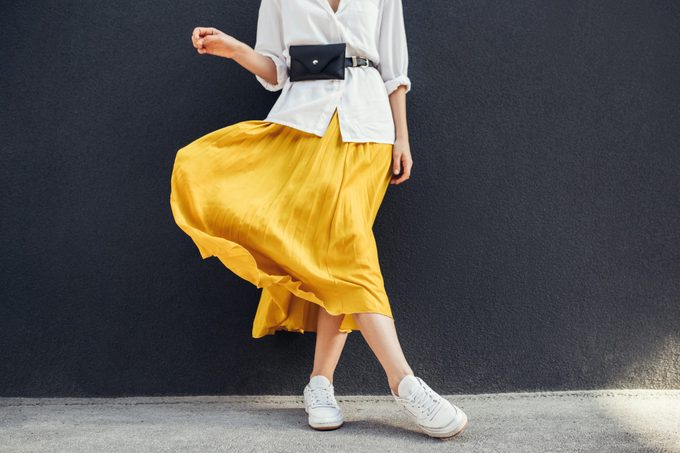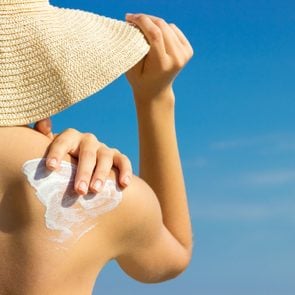Sun-Protective Clothing—What to Wear to Protect Your Skin
Updated: Aug. 08, 2022
Avoiding sun damage is a must to prevent premature aging and skin cancer—and the right sun protective clothing can be your sunshine suit of armor all season long.
Our editors and experts handpick every product we feature. We may earn a commission from your purchases.
Side effects of sun-bathing
Americans are prioritizing sun protection more than ever, according to a recent survey from the American Academy of Dermatology (AAD.) Yet the organization also found that most of us aren’t effectively putting sun safety into practice. It notes that not using enough sunblock to block harmful rays is a super common skincare mistake (researchers from King’s College of London found that the average person only applies enough sunscreen to get 40 percent of the necessary skin protection). Still, new data from the journal Cancers suggests we often overlook another major element of sunshine safety: sun protective clothing.
The 2022 study found that clothing designed for sun protection can provide a better barrier than sunscreen, especially considering the number of sunscreen mistakes we’re all making. And while it’s critical you apply sunscreen or sunblock to all exposed skin, the right clothing can work to shield your skin from ultraviolet (UV) damage.
Are you neglecting high-risk areas for skin cancer? Derms warn not to forget about these body parts.
Can the sun damage our skin through clothing?
So, you’ve slathered enough sunscreen on your arms, neck, and hands right up to the hem of your t-shirt. But when it comes to the sun, not all clothing is equal—and your favorite top may be leaving the skin beneath entirely exposed to UV damage.
Now, your skin really takes a beating under the sun. We expect it to forgive our sun-worshipping sins virtually on its own, and it can—to a point.
Your skin is designed to protect the body from environmental elements, including UV rays, says Anthony Rossi, MD, a dermatologist and assistant attending physician at Memorial Sloan Kettering Cancer Center in New York City.
But your skin can only take so much punishment before the sun’s UV light induces changes and mutations in our DNA. Specifically, skin cells called melanocytes produce melanin.
“The melanin acts like a hat over the skin cells to absorb the UV and protect the cells,” says Dr. Rossi. “Regardless of skin type, we all have the same number of melanocytes. What differs is how much melanin we make.”
Every time we are exposed to the sun, and when we tan or sunburn, we are experiencing DNA damage from the sun’s UV rays, he says. (And while you want to avoid damage as much as possible, derms point to these simple skincare steps that save your skin when you’ve caught too much sun.)
Remember: UV damage raises the risk of skin cancer, the most common cancer in the United States. It’s so widespread that there are two deaths from skin cancer every hour.
That’s where sunscreen and protective clothing can help and keep your skin healthy.
Look and feel your best with daily health and wellness wisdom from The Healthy @Reader’s Digest newsletter
Can clothes protect you from the sun?
Yes, if you choose wisely.
The dyes and fabric in our clothing absorb some harmful UV rays and keep them from penetrating our skin, but some shirts, pants, and hats protect us better than others. The stronger the protection your clothes offer, the higher their UPF—ultraviolet protection factor—number; UPF is a corollary to SPF (sun protection factor) for sunscreens.
“We know that pigmented, unbleached cotton, such as green and brown and tan, has greater natural UPF, as the fibers contain pigments, which serve as UV absorbers,” says Pooja Sodha, MD, director of cosmetic dermatology at George Washington Medical Faculty Associates in Washington, D.C.
But the color of your clothing is only one component of the UPF.
“There are other factors that dictate UPF, including fabric weight, fabric thickness, stitch density,” she says. “So this issue is more than just fabric type but also related to the fabric tightness and weave.”
Learn more about the most common summer health dangers to stay safe and healthy all season long

How to choose sun-protective clothing
Color
The dyes of dark and bright colors absorb more UV rays than lighter colors, such as whites and pastels, and help protect your skin better.
For instance, a white cotton T-shirt might have a UPF of 10, but a long-sleeved denim shirt has a UPF of 1,700.
Of course, the denim shirt’s darker color is only part of the reason its UPF is so much higher. Its thicker fabric contributes to the high UPF too. A white denim long-sleeved shirt has a higher UPF than a white cotton T-shirt.
Fabric construction
A light and airy shirt feels cooler when it’s hot out, but it leaves your skin vulnerable to skin damage.
Check the fabric density by holding it up to the light. If you can see the light coming through your shirt, you’ll need to wear sunscreen underneath the shirt to shield your skin from the sun.
Sheer, thin, or loosely woven fabrics let UV rays sneak in. Tightly woven fabrics—such as woven synthetic fibers, wool, denim, densely woven cloth, and canvas—help keep them out.
Fabric content
Don’t worry—you don’t have to wear heavy denim all summer to be protected from the sun.
You can still wear your favorite shiny polyester and satiny silk blouses because they reflect more light than matte fabrics. So do nylon, rayon, Lycra, and acrylic.
“But UV protection is a function of many fabric qualities. So, thin sheer silk will not be as protective as heavy denim white cotton,” warns Dr. Sodha.
When researchers tested clothing containing Lycra/elastane—a fabric often found in our favorite leggings and workout wear—in sun-drenched Australia, they found they had UPFs of 50 or higher.
That high sun protection factor was followed by nylon and polyester, according to the study, which was published in the journal Photodermatology, Photoimmunology & Photomedicine.
There’s another benefit to wearing these fabrics: they can keep you dry as you sweat in the heat.
“Natural fabrics like cotton help you absorb moisture, but newer synthetic activewear also helps to wick away moisture and prevent moisture from sitting on your skin and irritating it,” Dr. Rossi says.
Keeping sweat at bay is also important because when fabrics get wet, they become more transparent and lose some sun protection value.
Fit
We have another reason to covet loose-fitting clothing, and it has nothing to do with saving room for dessert.
Tight clothing isn’t just uncomfortable; it could be bad for your skin.
As the fibers and stitching pull and stretch, it lets in more UV light.
What is UPF clothing?
Sun-protective UPF clothing is specifically engineered to provide the most protection possible from UV rays.
“There are numerous methods for making UV protective clothing, including dyes used, textiles, and ingredients that impart UV protection, such as UV absorbers and finishes,” says Dr. Rossi.
Some manufacturers use sustainable plant extracts that absorb UV, such as anthocyanins, chlorophylls, carotenoids, and flavonoids.
The extracts, dyes, and other components that create UPF last wash after wash. Some companies even guarantee the UPF rating for the life of the garment.
What’s a good UPF rating?
The UPF rating found on the label indicates how much UV radiation passes through the fabric to your skin.
A shirt with a UPF 50 allows a minuscule amount of UV radiation—about 1/50th—to reach your skin.
By comparison, a white T-shirt with a UPF rating of about 10 allows 1/10th of UV radiation to permeate your skin.
The UPF rating ranges between 15 to 50, though if you want the official Skin Cancer Foundation Seal of Recommendation, choose clothing and accessories with at least a UPF 30. But a UPF 50 is considered excellent.
Is UPF clothing heavy and uncomfortable?
For the bright rays of sunshine in the winter, UPF clothing might seem more doable because it’s colder outside. (That said, be aware of these 12 reasons you age faster in the winter.)
Wearing long-sleeved shirts, pants, and hats in the blazing heat? Not so much.
Yet most UPF clothing is surprisingly lightweight, moisture-wicking, and comfortable. And if you’re wondering if UPF is geared more toward function than fashion, you may be surprised at how stylish it really is. Case in point:
- Columbia Women’s Chill River Hooded Tunic: The longer cut and hood provide extra protection with a UPF 50 rating.
- Coolibar Women’s Morada Everyday Long Sleeve T-Shirt: This shirt is for everyday wear and blocks 98 percent of UV radiation with a UPF rating of 50+.
- Coolibar Morada Everyday Long Sleeve T-Shirt: Like the women’s version, this men’s shirt blocks 98 percent of UV rays and has a UPF 50+ rating.

Cover your head
A baseball cap is better than no protection at all. But it still leaves a lot of the face and neck unprotected, says Chris Adigun, MD, a dermatologist at the Dermatology & Laser Center of Chapel Hill, North Carolina.
What should we wear instead? “A broad-brim hat, so it will protect your face, lateral face, ears, and ideally the back of your neck,” says Dr. Adigun.
The Skin Cancer Foundation recommends a three-inch brim circumference or at least a three-inch bill with a permanently attached drape covering the ears and neck. Some good picks:
- Wallaroo Hat Company Women’s Scrunchie Sun Hat: “Wallaroo makes great hats,” says Dr. Adigun. “You can literally roll them up into a ball, so they’re easy to pack.” This one has a UPF 50+ rating.
- Solbari Protective Everyday Sun Hat for Women: “I refer my patients to Coolibar and Solbari for clothing and hats,” says Dr. Sodha. This hat exceeds the recommendations, with a four-inch brim in the front and a six-inch brim in the back for neck protection. It also has a UPF rating of 50+.
- Coolibar Men’s Beach Comber Sun Hat: An oversized brim of four inches and a cotton-lined crown and sweatband keep your head extra cool on hot days. The UPF 50+ goes a long way toward blocking UV rays.
Don’t forget about your eyes! Here’s what eye doctors want you to know about taking care of your eye health in the sun
Protect your feet
When that first hot day rolls around, we’re all ready to ditch our suffocating, clunky shoes and break out the flip-flops and sandals—or keep our feet bare.
These options are comfortable and cool on a hot day, but they leave your feet exposed.
“I’ve seen people sunburn right through their jelly shoes and other types of lightweight mesh sandals,” says Dr. Adigun.
Whether you slip into a pair of flip-flops, mesh athletic shoes, or jelly shoes, it is essential to apply a water-resistant sunscreen.
You’ll be covered when you dip your toes into the pool or if you have sweaty feet, Dr. Adigun says. Be sure to reapply per instructions on the sunscreen.
Shield your hands
Our hands are routinely exposed to the sun, yet we generally pay more attention to our face and other body parts when we’re applying sunscreen.
You might subconsciously think you’ve covered your hands, so it’s easy to forget to apply sunscreen to the backs our hands.
Over time, sun exposure increases skin cancer risk and robs our hands of collagen, causing wrinkly, thin skin and little brown spots.
The Skin Cancer Foundation estimates that a whopping 90 percent of skin aging is caused by the sun. Sidestep aging and cancer by covering up with these sun-protection gloves:
- Coolibar Unisex Sawyer UV Sun Gloves: “I love the Coolibar UV Sun gloves, especially for driving,” Dr. Sodha says. With a UPF 50+, they’re ideal for long walks and hikes, or anytime your hands are exposed to the sun.
- Coolibar Men’s and Women’s Gannett UV Gloves: These gloves offer the same UPF 50+ protection, plus touchscreen compatibility.
Sunscreen vs. UPF clothes
The big advantage of UPF clothing is you don’t have to remember to reapply it.
Think back to the last time you were relying on sunscreen while poolside, at the beach, or outdoors all day: Did you end up with lobster-colored arms and legs and a burnt nose? Forgetting to reapply sunscreen every hour or so is how people end up with sun-damaged skin.
“UPF clothing is more effective at protecting skin from UV rays than sunscreens and does not wear off and does not require reapplication,” says Dr. Adigun.
You don’t need to wear sunscreen under UPF clothing, and that goes for rash guards made for water activities.
“If you are ever going to be in direct sunlight, UPF 50 clothing is what you should be wearing,” advises Dr. Adigun.
You’ll still need to apply sunscreen (and reapply as needed) for skin not covered by UPF clothing. Apply one of these sunscreens dermatologists use on themselves.
The Skin Cancer Foundation recommends rash guards, which are soft and light and designed to wear over your swimsuit, when you’re in or out of the water.
Here are some Skin Cancer Foundation-approved picks:
- Land’s End Women’s Crew Neck Long Sleeve Rash Guard with UPF 50
- Land’s End Women’s Crew Neck Elbow Sleeve Rash Guard witih UPF 50
- Land’s End Women’s Plus Size Crew Neck Elbow Sleeve Rash Guard with UPF 50
- Land’s End Men’s Spacedye Short Sleeve Swim Tee Rash Guard
- Land’s End Men’s Long Sleeve Swim Tee Rash Guard
- Land’s End Men’s Big and Tall Short Sleeve Swim Tee Rash Guard
Why UPF clothing is worth the investment
UPF clothing isn’t just for fair-skinned people who burn easily. Excessive UV exposure is harmful to everyone.
“People with skin conditions sensitive to UV exposure and a history of skin cancer are obvious appropriate candidates. But these products should be considered even in the young, as the cumulative damage of UV radiation starts in infancy,” says Dr. Sodha.
In fact, about 23 percent of lifetime sun damage exposure occurs before the age of 18. By the time we’re 40, that average climbs to 47 percent.
If you’ve already started to see some signs of sun damage, there are dermatologist-approved products you can use that may help reverse sun-damaged skin.
Protecting your skin from the sun with UPF clothing and sunscreen reduces the risk of skin cancer, aging, and other conditions.
“Sun protection is highly encouraged for the following goals,” says Dr. Sodha:
- prevention of skin cancer
- prevention of sun-induced aging
- prevention of flares of autoimmune diseases (such as lupus)
- prevention of flares of sun-induced skin rashes and sun allergies
- prevention of photosensitivity while using certain medications (such as the antibiotic doxycycline)
In short, it’s a very good idea to invest in some sun-protective clothing.
For the latest on sun safety and all-things-wellness, follow The Healthy on Facebook, Instagram, and Twitter. And check out these summertime must-reads:




